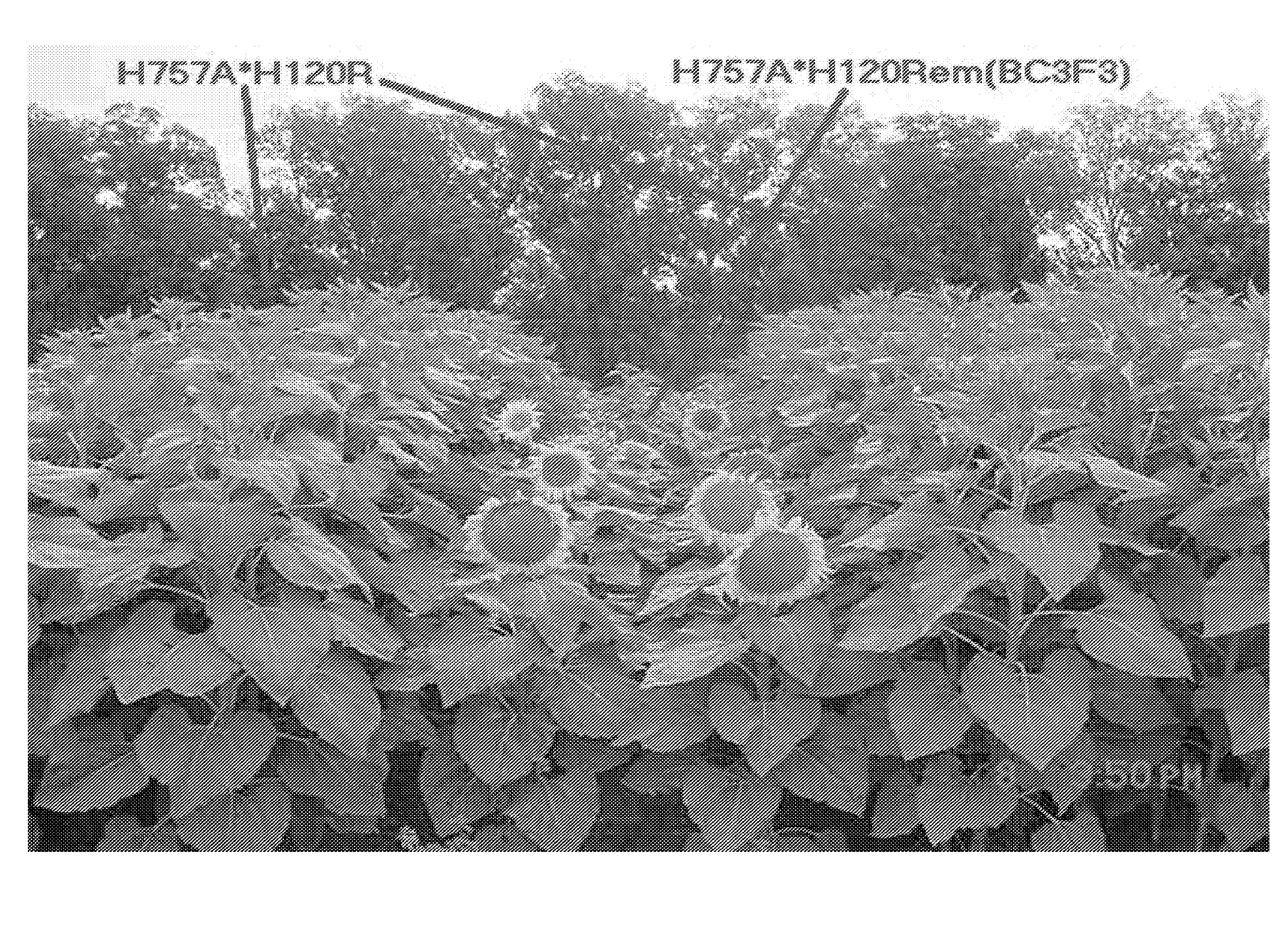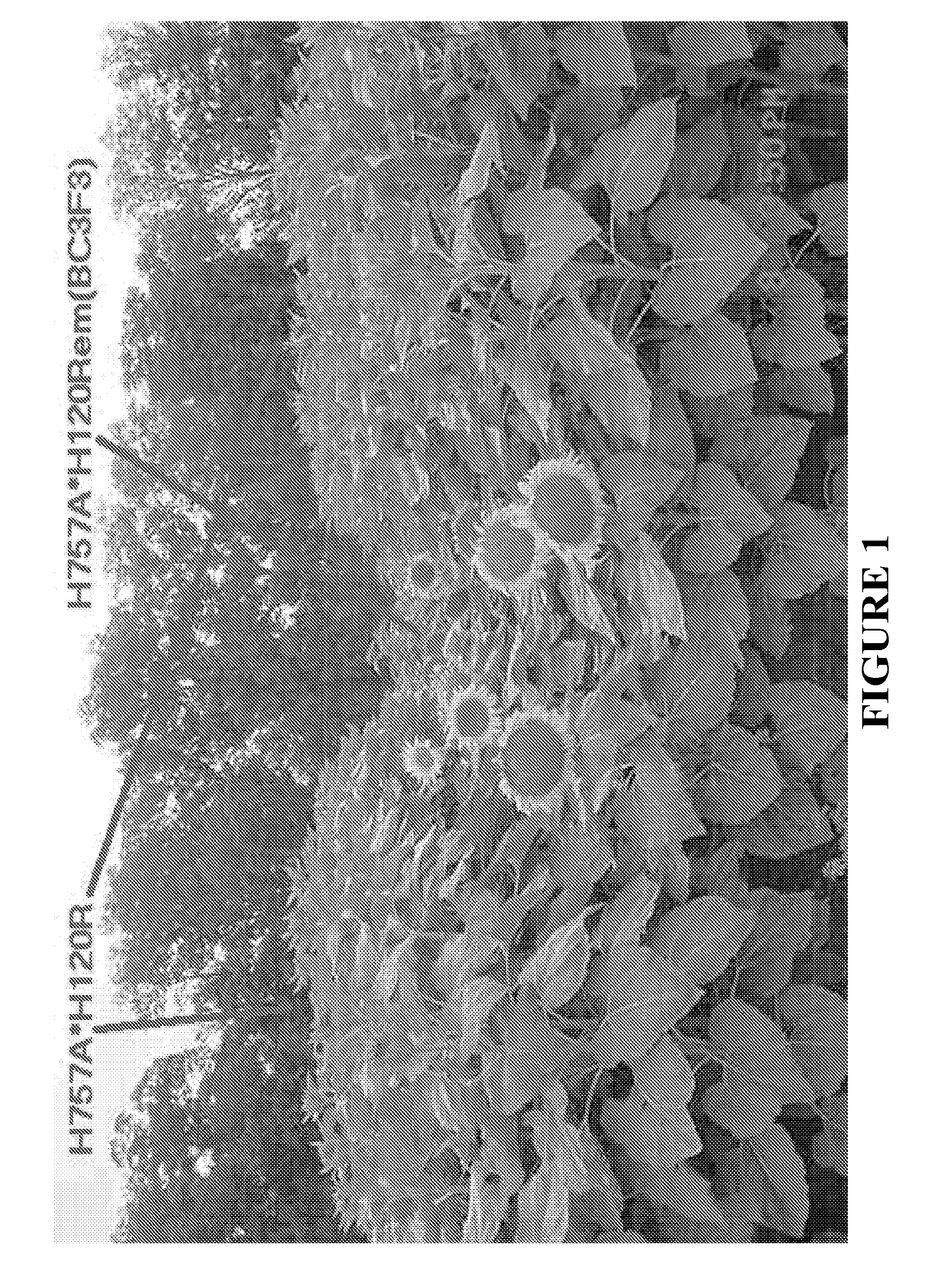Dominant earliness mutation and gene in sunflower (helianthus annuus)
a technology of helianthus annuus and earliness, which is applied in the field of dominant earliness mutation and gene in sunflower (helianthus annuus), can solve the problems of unpredictability, inbred lines that are developed are unpredictable, and time-consuming process for the development of new cultivars, so as to reduce the phenophase emergence flowering, increase the ic, and increase the toleran
- Summary
- Abstract
- Description
- Claims
- Application Information
AI Technical Summary
Benefits of technology
Problems solved by technology
Method used
Image
Examples
example 1
Agronomic Testing and Sample Results
[0057]This gene was originated by natural mutation in a sunflower breeding population. This gene was initially used to create hyper-early versions of early inbreds pursuing adaptation to short maturity regions. Later on its potential use to normalize hyper-late inbreds was understood and applied.
[0058]A set of experiments was carried out with the purpose to initiate characterization of the em gene in sunflower, using the following genotypes:[0059]MG2 H757A*H120R Wild type[0060]X223 H757A*EM229135R Early Mutant type[0061]EM229135R=H120Rem (BC2F7 homozygous)
Some of the highlights are the following:
TABLE 1Mean values for time to flowering (DtoFLW) andphysiological maturity (DtoPhM), of two sunflowerhybrids contrasting in earliness character.GenotypePd.m.sAttributeX223MG2Gα = 0.10DtoFLWB (day) 56*670.00 1DtoPhM (day)89990.1111G: genotype, d.m.s: significant difference.*= note reduction in DTF, but same length of seed filling period
TABLE 2Mean values f...
example 2
Characterization of Gene Dominance, Gene Dosage, and Application of the Em Gene for Reducing Phenophase Without Affecting the Filling Period
[0065]The subject mutation / mutated gene can be used to significantly reduce the phenophase “emergence-flowering” (V1-R5.1), without affecting the subsequent filling period (R5.5-R9), in the sunflower growing cycle; it could be used to convert very late “elite inbreds showing reduced Genotype Environment interaction” in earlier “iso-lines” for other geographies that require shorter maturity.
[0066]Two inbreds have already been converted (BC4+) and fixed (H840B and H418R), and one partially converted (BC2F7) but fixed (H120R). The em versions of both H840B and H120R fits perfectly the maturity normally used in North America. These em versions of inbred lines have even been useful to create hybrids of mg 3, being the recurrent inbreds mg 7 and mg 6, respectively. This hybrid performed earlier than 8377NS and near SF270.
[0067]H840B was used to make e...
example 3
Use of This Gene to Allow Expansion of the Sunflower Frontiers to Areas with Shorter Growing Seasons and More Limited Water Availability
[0071]Due to the significant reduction in that phenophase, the use of this gene can allow expansion of the sunflower frontiers to areas with shorter growing seasons and more limited water availability, by the combined use of elite iso-hybrids from other areas. Because of the pleiothropic effects of the gene on other traits, changes in the crop spatial distribution might be needed to maximize crop productivity. Antecedents such as Sunwheat and Sunola have been extensively tested, but with genetic background limitations.
[0072]An experiment has also been setup to study this kind of gene effects, and to quantify the effect of diverse spatial distribution in iso-hybrids, over the growth and developmental parameters and yield components.
TABLE 9Entry CodeGenGenotypeH757A / H120RF1(ee / ee)H757A / H120RemF1(ee / EE)H840A / H418RF1(ee / ee)H840A / H418RemF1(ee / EE)Factoria...
PUM
| Property | Measurement | Unit |
|---|---|---|
| mean time | aaaaa | aaaaa |
| width | aaaaa | aaaaa |
| circumference | aaaaa | aaaaa |
Abstract
Description
Claims
Application Information
 Login to View More
Login to View More - R&D
- Intellectual Property
- Life Sciences
- Materials
- Tech Scout
- Unparalleled Data Quality
- Higher Quality Content
- 60% Fewer Hallucinations
Browse by: Latest US Patents, China's latest patents, Technical Efficacy Thesaurus, Application Domain, Technology Topic, Popular Technical Reports.
© 2025 PatSnap. All rights reserved.Legal|Privacy policy|Modern Slavery Act Transparency Statement|Sitemap|About US| Contact US: help@patsnap.com



